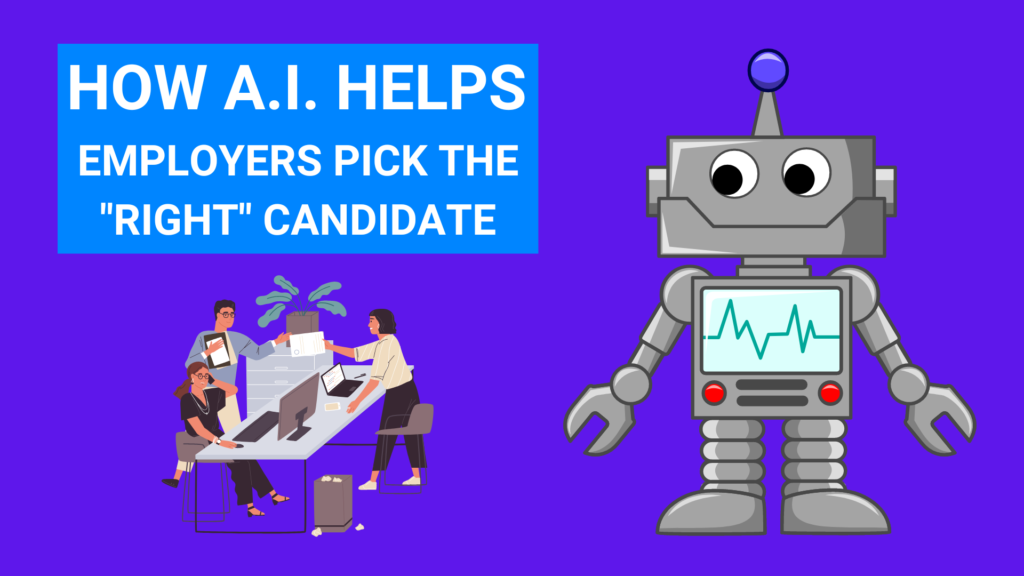How Artificial Intelligence helps employers pick the 'right" candidate
Artificial intelligence (AI) is becoming increasingly common in the hiring process, helping employers pick candidates more efficiently and accurately. Or at least they think they picking the more accurately. Here are some of the ways AI is being used in the hiring process to help employers pick candidates: Artificial intelligence (AI) is becoming increasingly common in the hiring process, helping employers pick candidates more efficiently and accurately. Or at least they think they picking the more accurately. Here are some of the ways AI is being used in the hiring process to help employers pick candidates:
According to a survey conducted by Gartner in 2021, 55% of HR leaders said their organizations have already implemented some form of artificial intelligence (AI) for recruiting purposes, while an additional 20% planned to do so by the end of 2021. This suggests that the use of AI in the hiring and screening process is becoming increasingly common.
* 55% of organizations have already implemented some form of .A.I for recruiting purposes *

1) Resume Screening with “Application Tracking Systems”
AI can help employers screen resumes more efficiently by quickly scanning and categorizing them based on keywords, qualifications, and experience. This can save employers time and help them identify the most qualified candidates for the job. AI can help employers screen resumes more efficiently by quickly scanning and categorizing them based on keywords, qualifications, and experience. This can save employers time and help them identify the most qualified candidates for the job.
AI can help employers screen resumes more efficiently by quickly scanning and categorizing them based on keywords, qualifications, and experience. This can save employers time and help them identify the most qualified candidates for the job. AI can help employers screen resumes more efficiently by quickly scanning and categorizing them based on keywords, qualifications, and experience. This can save employers time and help them identify the most qualified candidates for the job.
2) Video Interviews
AI can also be used to conduct video interviews, allowing employers to assess candidates remotely. AI algorithms can analyze factors such as facial expressions, tone of voice, and body language to provide insights on the candidate’s suitability for the job. AI can also be used to conduct video interviews, allowing employers to assess candidates remotely. AI algorithms can analyze factors such as facial expressions, tone of voice, and body language to provide insights on the candidate’s suitability for the job.
AI can also be used to conduct video interviews, allowing employers to assess candidates remotely. AI algorithms can analyze factors such as facial expressions, tone of voice, and body language to provide insights on the candidate’s suitability for the job. AI can also be used to conduct video interviews, allowing employers to assess candidates remotely. AI algorithms can analyze factors such as facial expressions, tone of voice, and body language to provide insights on the candidate’s suitability for the job.
3) Predictive Analytics
AI can use predictive analytics to help employers identify the most promising candidates for the job. By analyzing data such as previous job performance, education, and skills, AI can help identify which candidates are most likely to succeed in the role. AI can use predictive analytics to help employers identify the most promising candidates for the job. By analyzing data such as previous job performance, education, and skills, AI can help identify which candidates are most likely to succeed in the role.
AI can use predictive analytics to help employers identify the most promising candidates for the job. By analyzing data such as previous job performance, education, and skills, AI can help identify which candidates are most likely to succeed in the role. AI can use predictive analytics to help employers identify the most promising candidates for the job. By analyzing data such as previous job performance, education, and skills, AI can help identify which candidates are most likely to succeed in the role.
4) Personality Assessments
AI can also help employers assess a candidate’s personality traits, such as their level of empathy, communication skills, and problem-solving abilities. This information can help employers determine whether a candidate is a good fit for the company culture and the job requirements. AI can also help employers assess a candidate’s personality traits, such as their level of empathy, communication skills, and problem-solving abilities. This information can help employers determine whether a candidate is a good fit for the company culture and the job requirements.
AI can also help employers assess a candidate’s personality traits, such as their level of empathy, communication skills, and problem-solving abilities. This information can help employers determine whether a candidate is a good fit for the company culture and the job requirements. AI can also help employers assess a candidate’s personality traits, such as their level of empathy, communication skills, and problem-solving abilities. This information can help employers determine whether a candidate is a good fit for the company culture and the job requirements.
5) Diversity and Inclusion
AI can also help employers improve diversity and inclusion in the hiring process. By removing personal identifiers such as name, gender, and ethnicity from resumes, AI can help reduce unconscious bias in the hiring process and increase the likelihood of hiring a more diverse workforce.
In conclusion, AI is transforming the hiring process by helping employers pick candidates more efficiently and accurately. From resume screening to personality assessments, AI is providing valuable insights that can help employers identify the most promising candidates for the job. As AI continues to evolve, it is likely that it will play an even greater role in the hiring process, improving the overall effectiveness and efficiency of the process.
